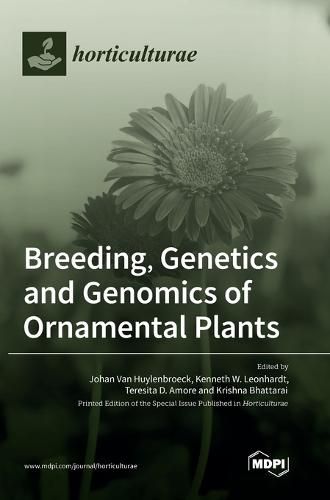Readings Newsletter
Become a Readings Member to make your shopping experience even easier.
Sign in or sign up for free!
You’re not far away from qualifying for FREE standard shipping within Australia
You’ve qualified for FREE standard shipping within Australia
The cart is loading…






This title is printed to order. This book may have been self-published. If so, we cannot guarantee the quality of the content. In the main most books will have gone through the editing process however some may not. We therefore suggest that you be aware of this before ordering this book. If in doubt check either the author or publisher’s details as we are unable to accept any returns unless they are faulty. Please contact us if you have any questions.
Ornamental crops account for more than US $42 billion globally. With the exception of few floral species, limited genetic, genomic, and breeding information is publicly available, owing to the fact that the majority of breeding work is performed by the private sector. Public research programs are increasingly participating in ornamental cultivar development and genetic studies. With lower sequencing costs, genomic information of non-model species including ornamental crops is continuously becoming available. Ornamental breeding utilizes a wide array of breeding strategies ranging from traditional crossing and selection methods to the use of next-generation sequencing in genomics and transcriptomics for gene identification and trait development. A continuing search of new species for the ornamentals industry has resulted in the utilization of tools that increase diversity and in the development of alternative methods for obtaining new crops by achieving interspecific and intergeneric crosses. This Special Issue aimed to present papers on new breeding methods, novel cultivars and species entering the ornamental industry, the identification of genes conferring novel traits, technological developments in ornamentals research, and the use of next-generation sequencing to improve ornamental plants.
$9.00 standard shipping within Australia
FREE standard shipping within Australia for orders over $100.00
Express & International shipping calculated at checkout
This title is printed to order. This book may have been self-published. If so, we cannot guarantee the quality of the content. In the main most books will have gone through the editing process however some may not. We therefore suggest that you be aware of this before ordering this book. If in doubt check either the author or publisher’s details as we are unable to accept any returns unless they are faulty. Please contact us if you have any questions.
Ornamental crops account for more than US $42 billion globally. With the exception of few floral species, limited genetic, genomic, and breeding information is publicly available, owing to the fact that the majority of breeding work is performed by the private sector. Public research programs are increasingly participating in ornamental cultivar development and genetic studies. With lower sequencing costs, genomic information of non-model species including ornamental crops is continuously becoming available. Ornamental breeding utilizes a wide array of breeding strategies ranging from traditional crossing and selection methods to the use of next-generation sequencing in genomics and transcriptomics for gene identification and trait development. A continuing search of new species for the ornamentals industry has resulted in the utilization of tools that increase diversity and in the development of alternative methods for obtaining new crops by achieving interspecific and intergeneric crosses. This Special Issue aimed to present papers on new breeding methods, novel cultivars and species entering the ornamental industry, the identification of genes conferring novel traits, technological developments in ornamentals research, and the use of next-generation sequencing to improve ornamental plants.